

NUMBER STRINGS - WHAT'S THE CHANGE? MENTAL MATH SUBTRACTION DECIMALS/MONEY - Google Slides. Twitter. Twitter. Inaba’s Place Value Puzzles: Making Connections and Asking “What If” – Embrace the Challenge. Last week, my sixth graders helped me make connections between a puzzle I used in third grade and their current work with place value, specifically multiplying and dividing by powers of ten.

Sarah Carter (@mathequalslove/Math Equals Love) introduced me to Naoki Inaba’s mathematical puzzles via her blog. She shared Zukei puzzles for geometric reasoning. Afterwards, I saw a few other people posting about other puzzles by Inaba. (Apparently some have even been featured in the NYT… I feel so behind the times!) On Inaba’s website, I found a puzzle Google Translate identified as “Zero Zero Expression,” I suppose because it involves zeroes…? The original puzzles (found here) gives a series of one digit numbers and a sum, and asks the student to multiply the one digit numbers by 1, 10 or 100 to balance the equation. The puzzles increase in difficulty. In this case, in order to get the 700, one can’t simply multiply a 7 by 100.
Third Graders at Work: “Where Do We Start?” Document available here. Fuss Free Number of the Day. CAMT is over, but my reporting isn’t.
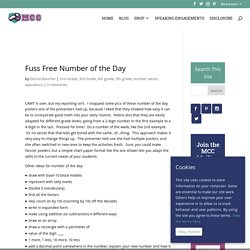
I snapped some pics of these number of the day posters one of the presenters had up, because I liked that they showed how easy it can be to incorporate good math into your daily routine. Notice also that they are easily adapted for different grade levels, going from a 2-digit number in the first example to a 4-digit in the last. Pressed for time? Do a number of the week, like the 2nd example. It’s no secret that that kids get bored with the same…ol’…thing. Student Closing Statements. For many teachers, nearing the end of class means preparing the classroom for the next class period and/or discussing homework.
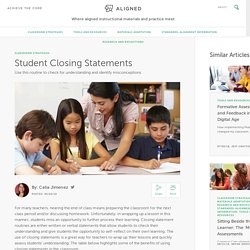
Unfortunately, in wrapping up a lesson in this manner, students miss an opportunity to further process their learning. Closing statement routines are either written or verbal statements that allow students to check their understanding and give students the opportunity to self-reflect on their own learning. The use of closing statements is a great way for teachers to wrap up their lessons and quickly assess students’ understanding.
The table below highlights some of the benefits of using closing statements in the classroom. There are different questions teachers can ask students at the end of a lesson to incorporate closing statements. An Interview with Sherry Parrish, author of Number Talks. Three years ago I had the pleasure of hearing Sherry Parrish and Ann Dominick speak at the NCTM Annual Meeting in New Orleans.
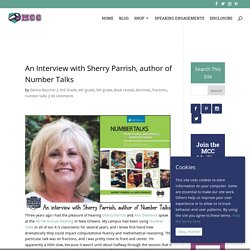
My campus had been using Number Talks in all of our K-5 classrooms for several years, and I knew first-hand how dramatically they could impact computational fluency and mathematical reasoning. This particular talk was on fractions, and I was pretty close to front and center. I’m apparently a little slow, because it wasn’t until about halfway through the session that it dawned on me that there might be a new Number Talks book in the works.
Sure enough, I learned that a Number Talks book for fractions and decimals was on the horizon. Fast-forward three years, the book is out, and I have the extreme pleasure of interviewing Sherry Parrish about the new book, Number Talks: Fractions, Decimals, and Percentages. #mathMovement ideas with well known Math Routines - Sara VanDerWerf. There are so many amazing math routines, many with websites full of resources.
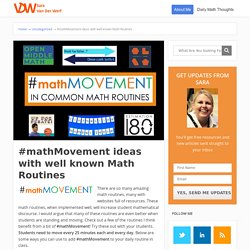
These math routines, when implemented well, will increase student mathematical discourse. I would argue that many of these routines are even better when students are standing and moving. Check out a few of the routines I think benefit from a bit of #mathMovement! Try these out with your students. Students need to move every 25 minutes each and every day. Do This, Not That: Aligning to Standards. As students spend increasingly more time engaged in independent math workshop tasks, it’s essential that we align those tasks to our content standards and math process standards.

This post is the second in a series of three. Check out the first post here, and there is a link to the last post in the series at the end of this post. This post contains affiliate links, which simply means that when you use my link and purchase a product, I receive a small commission. There is no additional cost to you, and I only link to books and products that I personally recommend. Workstations are always standards-based There are so many resources available to teachers these days. Provide practice for skills students are already confident in Teachers often tell me that all workstation tasks should be related to the current skill being taught. Spiral skills throughout the year. Using Interactive Number Lines to Support Number Sense - Mr Elementary Math.
I was just reminded of this great collection of Always, Sometimes, Never statements crowdsourced by the #MTBoS #ITeachMath crew a few years ago. Enjoy! Always Sometimes Never (Elementary) Frankschorn sur Twitter : "I love the concept. It helps kids go deeper into their own thinking. The bottom left ALWAYS statement is incorrect. It’s a mistake my middle school kids often make. Maybe let the kids post their statements, but then give them an. Contemplate then Calculate (MP7) – Fostering Math Practices. 20 Days of Number Sense & Rich Math Talk (K-12) - Steve Wyborney's Blog: I'm on a Learning Mission.
20 Days of Number Sense & Rich Math Talk – for all grades from K-12.
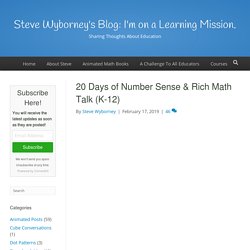
That is the goal of this series. Entirely new, exclusive content fills this post in a ready-to-use format that will allow you to deeply explore 4 rich math routines. By downloading each day, you can have a clear pathway to presenting rich number sense and math discourse opportunities to your students. Additionally, each day contains multiple levels, so that a 2nd grade teacher, a 5th grade teacher, and a high school teacher can all be using the same file – and can all have access to other grade levels. The opportunities to differentiate across levels abound in this series as well as the opportunities to see into other grade levels from K-12. Update: If you would like to read about Kathy Iwanicki’s journey into 20 Days of Number Sense & Rich Math Talk, you can find her blog post here.
Quick Access to Days 1-5 When you click on the day, the download page will open. Number Sense Routines - 2019 2-3.pdf. The Mind of an April Fool. Clothesline Math has been a growing trend in mathematics education.
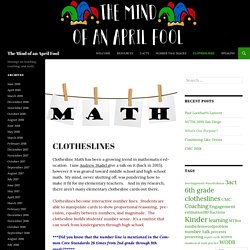
I saw Andrew Stadel give a talk on it (back in 2015), however it was geared toward middle school and high school math. My mind, never shutting off, was pondering how to make it fit for my elementary teachers. And in my research, there aren’t many elementary clothesline cards out there. Clotheslines become interactive number lines.
5 Steps to Building a Better Word Wall. It was raining again. My second-grade students were indoors for recess and enjoying free time when a student approached me and asked, “How do I spell because?” I responded, “That’s a tricky one—have you checked the word wall?” The student answered with a familiar tune, “Oh yeah! I forget about the wall sometimes, it’s so high up.” She waltzed over to the word wall and craned her neck to find the word because written at the top of the wall, in my handwriting. Using Math Stretches for a Daily Warm-Up. Routines: Grade 3 Mathematics. Math Flips – Math Visuals. Math Flips are flashcards with a problem on the front and a similar problem on the back (instead of a problem and an answer) to encourage relational thinking rather than answer-getting.
Steve Wyborney's Blog: I'm on a Learning Mission. – Sharing Thoughts About Education. Stevewyborney. Counting With Your Eyes: The Importance of Subitizing For Developing Math Understanding. Have you ever looked at a group of items and just knew how many there were without actually counting?

This ability to “see” how many items are in a group without counting is called subitizing. The ability to subitize is an important part of developing a strong mathematical foundation and understanding of number (Baroody 1987, 115). Playing with dice, dominoes, and asking children to find a specific number of items will help them develop subitizing skills and a sense of quantity. Asking to guess how many items you are holding will help develop estimation skills, which is another very important skill that will help children develop their mathematical skills.
Counting With Your Eyes: Look At The Dots An interesting activity to do with children and adults is to have them look at the image of the dots below for just a few seconds and then look away (or remove the dots from their view). SAME BUT DIFFERENT MATH. Mathematical Routines.